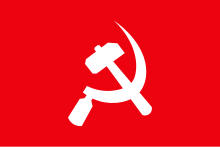| Naxalbari Uprising | |||||||
|---|---|---|---|---|---|---|---|
| Part of the Cold War and Naxalite Insurgency | |||||||
 The South Asian communist banner | |||||||
| |||||||
| Belligerents | |||||||
|
Supported by: |
Supported by: | ||||||
| Commanders and leaders | |||||||
|
|
| ||||||
| Units involved | |||||||
|
Indian Police Service West Bengal Police |
| ||||||
| Casualties and losses | |||||||
| 1 police died | 11 rebels died | ||||||
Naxalbari uprising (Bengali: নকশালবাড়ি বিদ্রোহ, romanized: Nokshalbari Bidroho) was an armed peasant revolt in 1967 in the Naxalbari block of Siliguri subdivision in Darjeeling district, West Bengal, India.[2][3] It was mainly led by tribals and the radical communist leaders of Bengal and further developed into the Communist Party of India (Marxist–Leninist) in 1969. The armed struggle became an inspiration to the Naxalite movement which rapidly spread from West Bengal to other states of India creating division within the Communist Party of India (Marxist) - India's primary communist party.[4]
- ^ Singh, Prakash. The Naxalite Movement in India. New Delhi: Rupa & Co., 1999. p. 24.
- ^ "History of Naxalism". Hindustan Times. 15 December 2005. Archived from the original on 22 February 2018. Retrieved 2 March 2018.
- ^ Shashi Shekhar (21 May 2017). "50 years of Naxalbari: Fighting for the right cause in the wrong way". Hindustan Times. Archived from the original on 21 May 2017. Retrieved 2 March 2018.
- ^ "The Naxalbari Uprising". 30 years of Naxalbari. Archived from the original on 31 October 2010. Retrieved 2 March 2018.